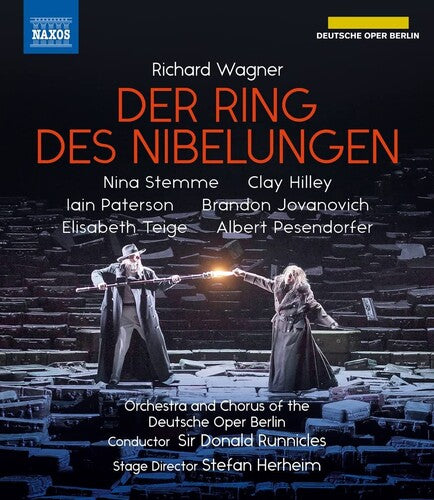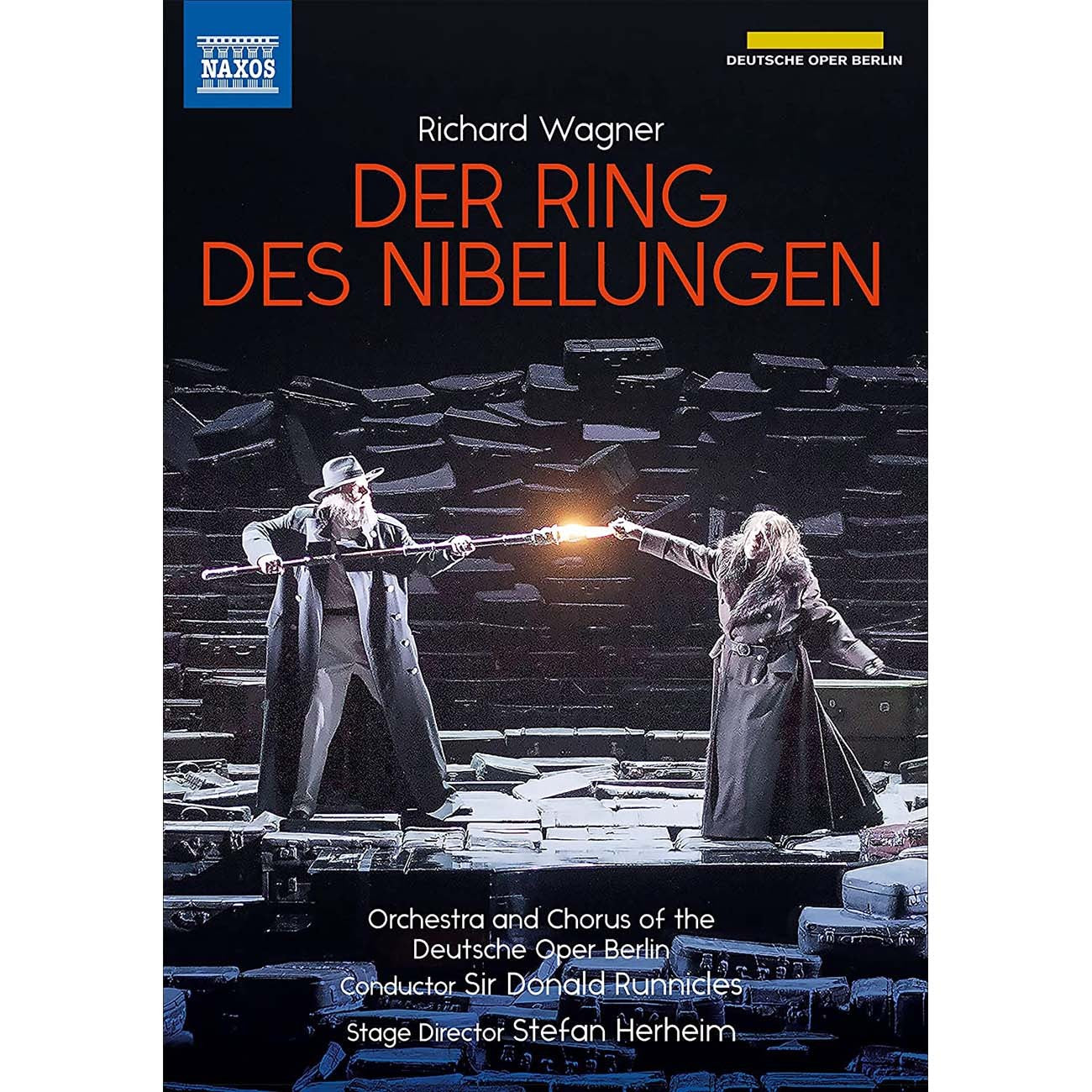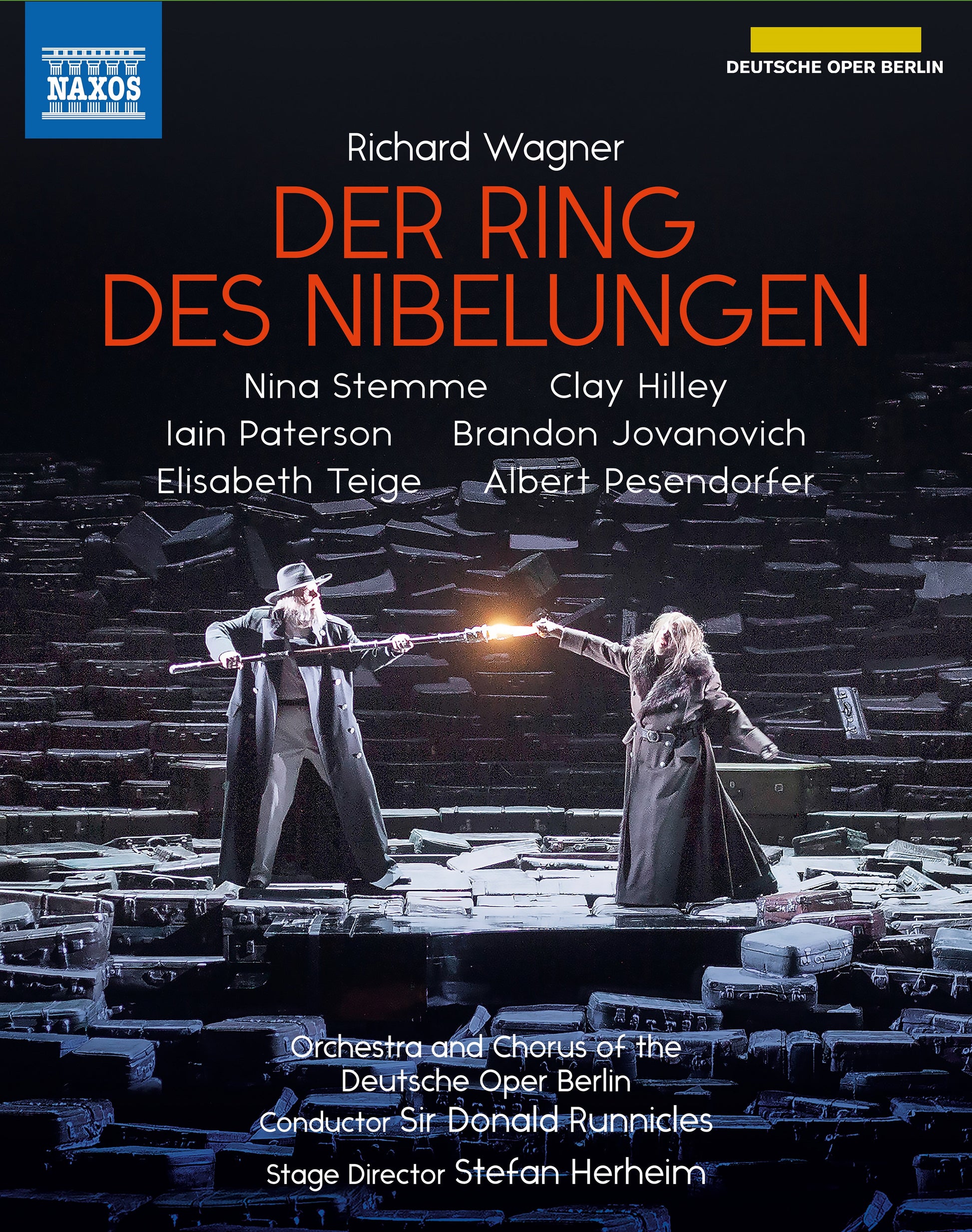Wagner: Der Ring Des Nibelungen (Box-Set)
Wagner: Der Ring Des Nibelungen (Box-Set)
Couldn't load pickup availability
The tetralogy of four operas that form Der Ring des Nibelungen (‘The Ring of the Nibelung’) explores the conjunction of love and power in a mythic landscape in which true power resides in possession of the ring. Composed over more than a quarter of a century, monumental in scale, and structured after the precedent of Greek drama, the cycle was first performed in 1876. Staged by the award-winning director Stefan Herheim, this innovative new production from Deutsche Oper Berlin features a leading international cast conducted by Sir Donald Runnicles.
REVIEW:
The Deutsche Oper Berlin is an important Wagner house, once dubbed “the winter Bayreuth”. This Ring, directed by the Norwegian Stefan Herheim, had a very long-serving predecessor in Götz Friedrich’s much-admired cycle that ran for 33 years (1984–2017).
Das Rheingold introduces several of the design tropes that unite the cycle visually and dramaturgically. Herheim is aware that this is in Berlin, and there are some World War Two and Wehrmacht references, about which he is quite unapologetic, speaking in the Rheingold booklet of “a chapter in German history which…systematized the extinction of entire people groups”. Those suitcases symbolize more than voluntary migration.
Derek Welton and Annika Schlicht have impressive voices well suited to their roles, although Fricka’s affectedly silly acting manner sometimes takes playfulness a bit far. Equally well sung are the Loge of Thomas Blondelle, the Freia of Flurina Stucki, and the Erda of Judit Kutasi, but then, this whole cycle deploys a seasoned Wagner cast, with few weak links.
The final scene leads us to Die Walküre, for which we need major new characters to be born, namely Brünnhilde, Siegmund, and Sieglinde. That means Wotan has some procreative work to do, so he does not enter Valhalla, but goes down through the prompt box whence Erda arose, there to sire with her the warrior maiden who is the Valkyrie of the title.
Die Walküre brings a change of Wotan, and another experienced Wagnerian, Iain Paterson, gives a sympathetic, authoritative, and well-sung account of his immensely demanding role. His huge Act 2 monologue – sometimes cited as one of longueurs of the Ring – is compelling. Hunding’s rather one-dimensional role is always watchable in Tobias Kehrer’s strongly played interpretation. Brandon Jovanovich’s Siegmund has pathos and when needed, vocal power, but Elisabeth Teige’s Sieglinde takes the vocal honors for a beautiful and touching portrayal. Nina Stemme is now a veteran Brünnhilde, having sung that and other Wagner leading roles all over the world, and she is probably still heading the list for casting directors of major opera houses; certainly she is on ringing form.
Herheim brings a surprise addition to the cast of Die Walküre in inventing the role of Hundingling, a young, soft-toy cuddling offspring of Hunding and Sieglinde. He is not mere decoration but plays a real role in Act 1, interacting with his bullying father and occasionally irritable mother, and often being comforted by the newly arrived stranger who seems to resemble his mother. Herheim explains in the booklet that this child is the embodiment of the shame Sieglinde feels about her enforced marriage. As Siegmund pulls the sword from the tree (or piano keyboard), Sieglinde slits the throat of Hundingling, who falls dead. Herheim references Medea, and says Sieglinde makes the tragic mistake of thinking the sacrifice of Hundingling is necessary for her to extricate herself.
In the third act, the opening “Ride of the Valkyries” begins with the Valkyries appearing out of the migrant crowd and donning proper Valkyrie kit – well, helmets and spears. The playing of the “Ride” itself has the usual wrong accenting, but most conductors ignore Wagner’s specific instruction that the main stress is always on the first beat (“I’m sick on a see saw”, not “I’m sick on a see saw”). Maybe the singers, as they perused the score on stage, and who do occasionally ‘conduct’ one another, could have given the correct beat! The fallen heroes arise from under their winding sheets and act as sex pests to the Valkyries, with Wotan’s seeming approval, a sign maybe of how he sees love. The end of Act 3 is strong as ever, tenderly affecting as Wotan bids farewell to his favourite daughter, and banishes Brünnhilde to her rock (or piano) against a curtain of flames, as the migrants look on in concern.
Talking points in Siegfried begin with Mime’s costume. He has the whiskers and hat of the mature Wagner, and the striped jacket of a concentration camp prisoner – so both notorious antisemite and a victim of that racist prejudice. Siegfried’s bear is none other than Alberich, who wonders into other scenes where the text does not place him. Siegfried is garbed traditionally, for some costumes reference the design history of the Ring. He also forges Nothung convincingly enough, hammer taps and all, and when it’s done, a map of the world briefly covers the stage, suggesting he could now conquer it all. The Woodbird is a boy soprano, as the composer initially intended. He does not sing his music very convincingly alas, and for some reason later adopts Alberich’s clown make-up. The dragon is a pair of enormous glowing eyes, and a mouth full of sharp teeth, and extras wielding the giant bells of brass instruments (the fight is a noisily brassy piece, and the weakest music in the Ring). We have a new singer for Alberich, Jordan Shanahan, who is as effective as his predecessor.
In Götterdämmerung the now familiar features of this production are used and varied, adding aspects of the opera house itself including its audience. Thus the sculptural metal feature of interlinked discs from the foyer is now an onstage backdrop to the opening scene, where Hagen, in modern dress, sips his interval drink at a table. He fetches Waltraute from the front row of the stalls, where he dozes through his nocturnal colloquy with Alberich. As before characters operate some of the time, e.g. for the blood brotherhood oath, in their underwear. There are some details of which the meaning is elusive, such as the burning man crossing the stage in Act 2, just as Hagen begins to summon the Gibichungs. Others, such as Gunther joining Siegfried in visiting Brünnhilde in the final scene of Act One and sharing his lines, instantly make some dramatic sense. As befits this mighty closing work of the tetralogy, there is plenty of spectacle to bring the cycle to a blazing conclusion.
The new singers are uniformly very good. Hagen is the vocally and physically imposing Albert Pesendorfer, wonderfully baleful in his night watch. His half-brother Gunther is also well sung and acted by Thomas Lehman. His sister Gutrune is the assured Aile Asszonyi, and Okka von der Damerau sings Waltraute with touching beauty; her scene with Brünnhilde is a strong one.
The Brünnhilde of Nina Stemme and Siegfried of Clay Hilley bring the same qualities heard in Siegfried. The American Heldentenor was a sensation as a last-minute replacement at Bayreuth’s 2022 Götterdämmerung, and should be heard by anyone who fears that no-one can truly sing the role these days. He has the range, the shining sound, the musicality and stamina required. Nina Stemme also has those qualities, but is about twenty years Hilley’s senior. All those performances of the repertoire’s most demanding roles begin to take a toll, of course, and she perhaps tires as this performance progresses, with one or two top notes ‘spreading’ – but really it matters little, for she triumphs over the difficulties and remains the consummate performer of this role.
Runnicles and the Orchestra of the Deutsche Oper Berlin are superb throughout, as is the chorus (in Götterdämmerung Act 2). Their familiarity with this work shows in the confidence of the playing, and the orchestral set pieces such as Siegfried’s Funeral Music are tremendous. If you want to hear incandescent playing in Wagner, try the Prelude to Act 3 of Siegfried, but the many subtle moments (always listen for the bass clarinet in Wagner) are deftly touched in, too. You will realise that Nietzsche, in calling Wagner a supreme miniaturist, was not just indulging his fondness for paradox.
The filming and surround sound are excellent. The filmed interview and Herheim’s contribution to the booklets are very useful addition in explaining his concept. Perhaps it will be worth consulting both ahead of viewing each opera, but there is also merit in viewing these works as if it is opening night in the Deutsche Oper, and you don’t know what you will see until the curtain rises. Then, to quote T.S. Eliot’s The Waste Land, you can “get the beauty of it hot”. If that beauty is mainly in the highly eloquent singing and playing, you will find much to impress, question, debate and decode in the innovative production.
-- MusicWeb International
Share
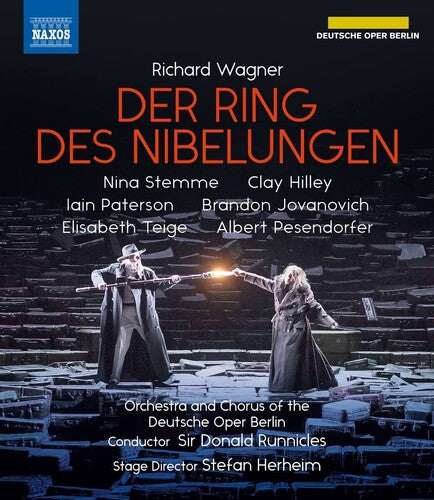

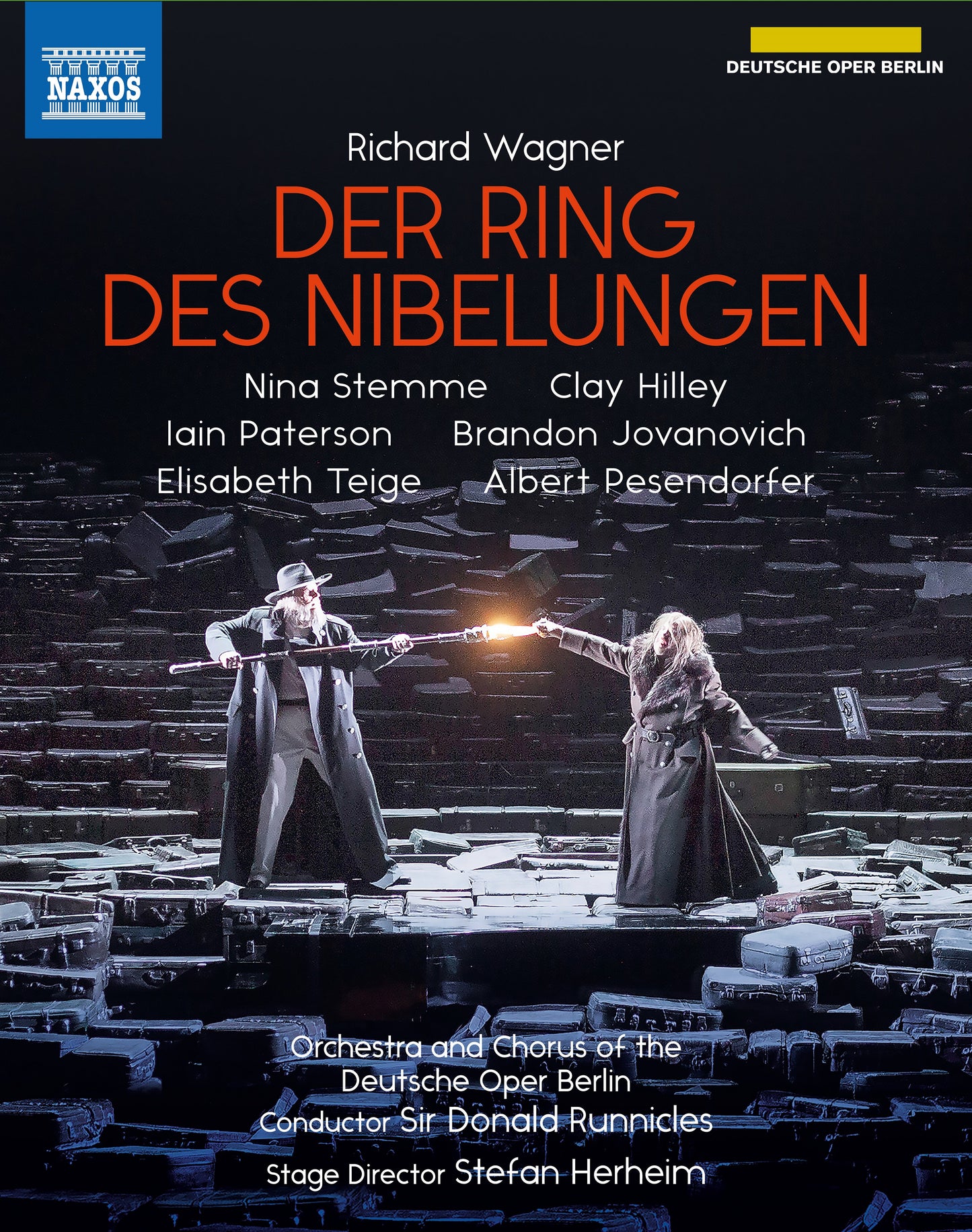
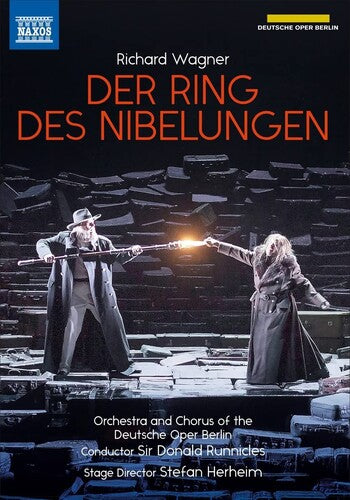
Product Description:
-
Release Date: November 11, 2022
-
UPC: 730099015660
-
Catalog Number: NBD0156VX
-
Label: Naxos AudioVisual
-
Number of Discs: 7
-
Composer: RICHARD WAGNER
-
Orchestra/Ensemble: Chorus Of The Deutsche Oper Berlin
-
Performer: Albert Pesendorfer, Brandon Jovanovich, Clay Hilley, Elisabeth T
Works:
-
The Ring of the Nibelung
Composer: Richard Wagner
Ensemble: Orchestra of the Deutsche Oper Berlin, Chorus of the Deutsche Oper Berlin
Conductor: Donald Runnicles

